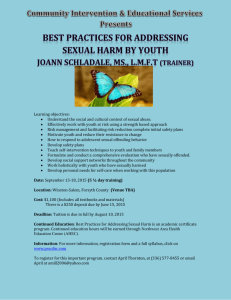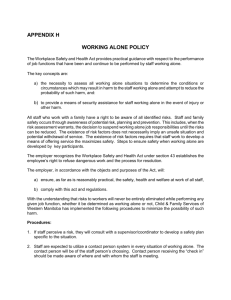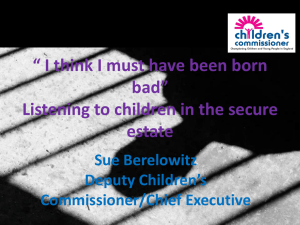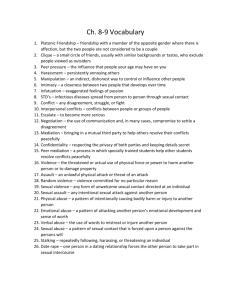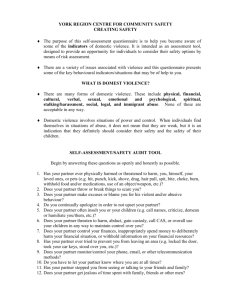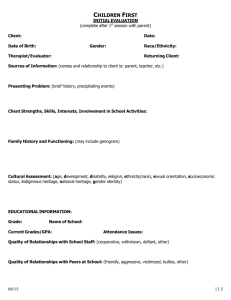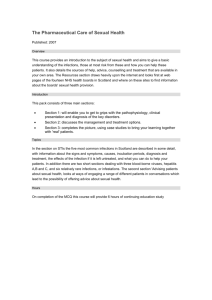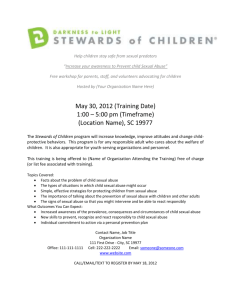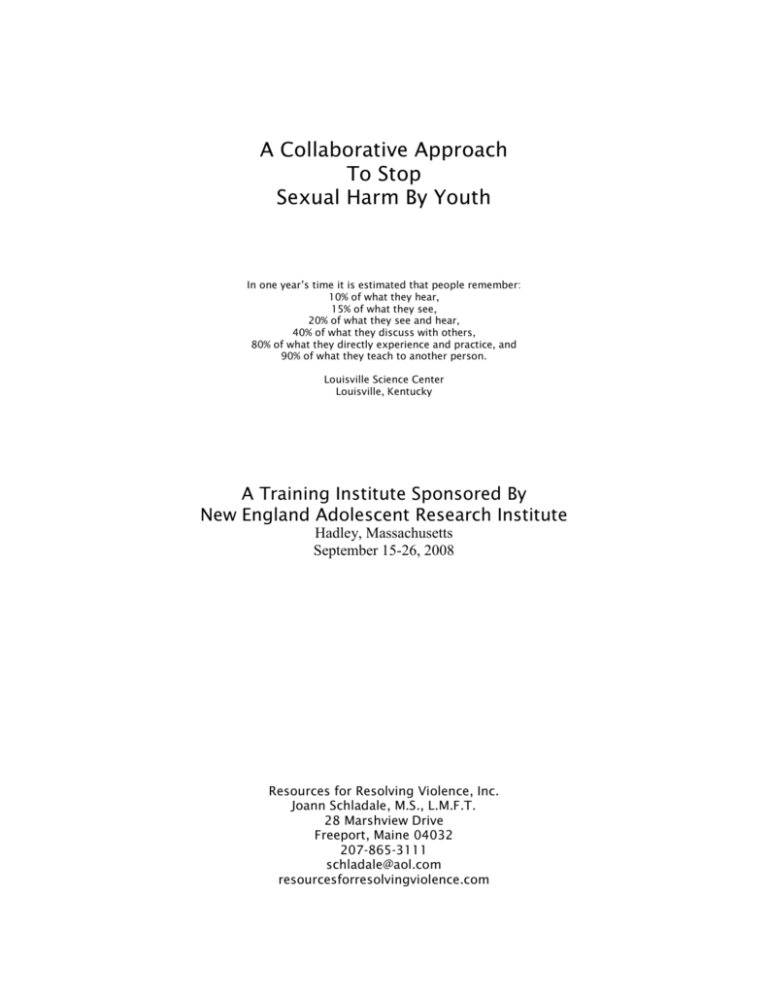
A Collaborative Approach
To Stop
Sexual Harm By Youth
In one year’s time it is estimated that people remember:
10% of what they hear,
15% of what they see,
20% of what they see and hear,
40% of what they discuss with others,
80% of what they directly experience and practice, and
90% of what they teach to another person.
Louisville Science Center
Louisville, Kentucky
A Training Institute Sponsored By
New England Adolescent Research Institute
Hadley, Massachusetts
September 15-26, 2008
Resources for Resolving Violence, Inc.
Joann Schladale, M.S., L.M.F.T.
28 Marshview Drive
Freeport, Maine 04032
207-865-3111
schladale@aol.com
resourcesforresolvingviolence.com
A Collaborative Approach To Stop Sexual Harm By Youth
Syllabus and Course Requirements
This course has been created to provide an intensive didactic and experiential study of
the dynamics and treatment with youth who have caused sexual harm and their family
members. The content includes a comprehensive overview of a full continuum of care
highlighting a clearly defined process of treatment.
The course has been approved for continuing education credits for qualified mental
health providers (QMHP). Specifically, six hours of ethics are covered through daily
discussion during each topic, and six hours of cultural diversity on Day Two, are
included.
By the end of this training participants will be able to:
•
•
•
•
•
•
•
•
•
•
•
Understand the social and cultural context of the abuse.
Coordinate treatment within all systems of care.
Practice therapeutic engagement techniques that may reduce resistance to
treatment.
Formulate and conduct a comprehensive, structured approach for assessment.
Identify the process of treatment and therapeutic tasks associated with each.
Utilize a multi-systems approach that involves public and private service agencies.
Provide interventions that meet the intellectual level of each client.
Recognize psychoeducational resources for enhancing harm reduction.
Coordinate the development of each youth's social support network.
Teach each youth self-intervention techniques.
Address personal needs for self-care when working with this population.
Successful completion of this course requires:
•
•
•
Attendance and participation in discussion based upon required readings.
Completion of written assignments and a final self-assessment.
Preparation of daily reading outlines as designated in the course schedule.
Text Books:
Harris, R. & Emberly, M. (1994). It's Perfectly Normal.
Cambridge, MA: Candlewick Press.
Longo, R. & Prescott, D. (2006). Current Perspectives: Working With
Sexually Aggressive Youth and Youth With Sexual Behavior Problems.
Miller, W. & Rollnick, S. (2002). Motivational Interviewing. Guilford Press.
Schladale, J. (2002). The T.O.P.* Workbook For Taming Violence and
Sexual Aggression.
A reading packet of relevant professional articles are also required reading.
They are identified throughout the Course Outline
Specific reading outlines are assigned for each day and are turned in for credit.
Evaluation Scale:
Points
Class Participation
30
Reading Outlines
Group Exercises
Final Evaluation
Total Points
35
5
30
100
(75% required for successful completion)
Preliminary Readings
(Outlines for this material are due Monday morning)
Text Books:
Longo, R. & Prescott, D. (2005).
Chapter 1: Current perspectives: Working With Young People Who Sexually Abuse
Chapter 4: Developmental Considerations In Working With Juvenile Sexual
Offenders
Chapter 13: Building A Holistic Approach In The Treatment Of Young People Who
Sexually Abuse
Chapter 20: Family Matters: The Importance of Engaging Families In Treatment
With Youth Who Have Caused Sexual Harm.
Chapter 26: Words From The Heart: The Process Of Change With Sexually
Abusive Youth
Chapter 28: Can We Develop Evidence-Based Practice With Adolescent Sex
Offenders
Chapter 29: Young People Who Sexually Abuse: Celebrating Progress And
Looking Towards The Futures
Miller, W. & Rollnick, S. (2002).
Chapter 1: Why Do People Change?
Chapter 2: Ambivalence: The Dilemma of Change
Chapter 3: Facilitating Change
Chapter 4: What Is Motivational Interviewing?
Chapter 13: Reflections on Learning
Binder:
Schladale, J., langan, T., Barnett, P., Nunez, J. Fredricks, K., Moylan-Trigiano, J. & Brown,
D. (2007). Community-Based Standards For Addressing Sexual Harm By Youth.
Schladale, J. (2006). Process of Treatment.
Course Outline
Week One
Monday Morning: Creating a Foundation For Collaboration
Participation in this course requires intensive submersion into the topic of youthful
sexual harm. In an effort to maximize learning and memory retention, this course
provides an educational experience that parallels the treatment process. It begins with
global issues relating to youthful sexual harm and moves into specifics of evidencebased best practice interventions.
Monday Afternoon: Values and Beliefs About Sexual Behavior
The topic of sexuality in the United States is a highly charged issue that impacts many
elements of our social fabric. Sexual issues are prevalent in politics, advertising,
religion, television and movies, and human development across the lifespan. Values and
beliefs of the youth and families we serve greatly impact intervention. Treatment
provider's belief systems can also influence successful outcome.
Tuesday Morning: Understanding the Social Context of Sexual Abuse
Social attitudes regarding sexuality and gender influence attitudes about behavior and
the use of violence. Faulty belief systems place a youth at risk for sexual offending.
Treatment provider's belief systems can also influence successful outcome.
Readings:
Taffel, R. (2006). The Divided Self. Family Therapy Magazine,
July/August.
Cox, A. (2006). Lost in Electronica. Family Therapy Magazine,
July/August.
Tuesday Afternoon: Culture, Ethnicity and Sexual Abuse
Ethnic, cultural and family beliefs can contribute to the creation of a high risk setting for
sexual abuse. Understanding such influences may decrease risk of harm.
Readings:
Hunter, J. (2005). Chapter 2: Understanding Diversity In
Juvenile Sexual Offenders: Implications For Assessment, Treatment, And
Legal Management.
Wednesday Morning: Guiding Principles of Treatment
Working with this population necessitates interventions based upon the strengths,
competencies and resources of each family. A collaborative approach incorporates
individual, group and family therapy, as a means for achieving treatment goals.
Readings:
Jenkins, A. (2006). Chapter 5: The Politics of Intervention:
Fairness and Ethics.
Jenkins, A. (2006). Chapter 17: Discovering Integrity: Working With
Shame Without Shaming Young people Who Have Abused.
Wednesday Afternoon: Therapeutic Engagement and Inviting Client Responsibility
The goal for therapy with sexually aggressive youth and their families is to support them
in assuming responsibility for their actions in order to prevent future harm. The first
priority is to engage all participants in such a way that they are motivated to integrate
positive change into their lives.
Reference:
Miller, W. & Rollnick, S. (2002).
Chapter 5: Change and Resistance: Opposite Sides of a Coin
Chapter 6: Phase 1: Building Motivation for Change
Chapter 7: Responding to Change Talk
Chapter 8: Responding to Resistance
Chapter 9: Enhancing Confidence
Chapter 10: Phase 2: Strengthening Commitment to Change
Thursday: Psychosocial Assessment
Assessment is an integral and ongoing process that provides a foundation for treatment.
The initial focus of assessment is to determine how a youth has come to cause sexual
harm; what family strengths and vulnerabilities can influence outcomes; static and
dynamic risk factors for re-offense; and protective factors that mitigate risk.
Readings:
Schladale, J. (In Press). Empiricaly Driven Assessment of Juvenile Sex
Offenders.
Friday Morning: Understanding Histories of Previous Trauma
Sexually aggressive youth have a history of pain in their lives that led them to make
perilous choices in an attempt to manage unresolved issues relating to previous trauma.
Treatment providers balance exploration of past victimization while maintaining a focus
on accountability for the youth's harmful behavior.
Readings:
Friedrich, W. & Sim, L. (2006). Chapter 14: Attachment Styles And
Sexual Abuse.
Rothschild, B. (2004). Applying the Brakes. Psychotherapy Networker,
Wylie, M. (2004). The Limits of Talk. Psychotherapy Networker.
Friday Afternoon: Therapists Issues and Self-Care
Providing treatment for this population is a quite a challenge! Inviting client
responsibility often requires extraordinary professional effort. Awareness of how this
work impacts personal and professional development can enhance career satisfaction
and reduce burnout.
Readings:
Wylie, M. & Markowitz, L. (1992). Walking the Wire. The Family
Therapy Networker, 16:5,18-31.
Week Two
Monday Morning: Sexual Health and Development
Understanding human sexual development is a complex, life long journey. Teaching
children about sexual expression that does not cause harm creates a foundation for
healing and harm reduction.
Readings:
Brown, S. & Schwartz, C. (2005). Chapter 7: Promoting Healthy
Sexuality In Sexually Abusive Youth
Cohen, K. (2005). Psychotherapy With Same-Sex Attracted Youth. Family
Therapy Magazine, November/December, 42-45.
Harris, R. & Emberly, M. (1994). It's Perfectly Normal.
Nolan, T & Nucua, A. (2005). “Throwaways”
Lesbian/Gay/Bisexual/Transgender Youth in Crisis. Family Therapy
Magazine, November/December, 34-37.
Monday Afternoon: Facilitating A Therapeutic Process
Integrating salient elements from the field of youthful sexual harm requires thoughtful
planning, assessment and implementation. Service providers committed to enhancing
successful treatment outcomes can maximize effectiveness through the creation and
maintenance of policies and procedures that reflect evidence-based practice.
Tuesday Morning: Mapping the Trauma Outcome Process
Understanding the impact of trauma is accomplished through exploring patterns of
behavior. This information solidifies knowledge of how they came to respond to
difficulties in this manner and how it affects their victims, others and themselves.
Readings:
Schladale, J. (2002). The T.O.P.* Workbook for Taming Violence and
Sexual Aggression.
Tuesday Afternoon: Eliminating Patterns of Abuse
In order to resign from an abusive lifestyle, each youth must understand what events,
thoughts, feelings and beliefs lead to harmful responses. These sequential patterns are
defined by high risk interactions that evolved into a cycle of violence and abuse.
Adolescents can learn to identify such patterns and intervene to reduce harm.
Wednesday: Promoting Ongoing Change
Once they are able to discern pattern of abuse youth are supported in experimenting
with new, ways to manage difficult experiences without causing harm. Treatment now
focuses on a broad range of situations in order to practice self-interventions. This day
involves participation in experiential activities created specifically for sexually
aggressive youth and their family members.
Thursday: Planning for Continued Success
Each youth develops a detailed plan for self-intervention to decrease the likelihood of
continued harm. This plan for continued success becomes the framework for transition
planning and aftercare services.
Readings:
Schladale, J. (2007). A Collaborative Approach For Family
Reconciliation And Reunification With Youth Who Have Caused Sexual
Harm.
Friday Morning: Evaluation
Every treatment provider who works with this population has ethical considerations for
maintaining professional competency. Evaluation and self-assessment are reflected
through the completion of a written exercise that provides a review of the material
covered throughout the training institute.
© Copyright 2007
Resources for Resolving Violence
Joann Schladale, M.S., L.M.F.T.
28 Marshview Drive
Freeport, Maine 04032
(207)-865-3111

